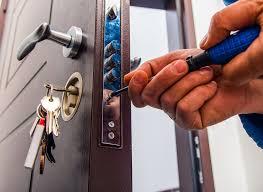Critical Entry Points: Keeping Your Home Secure

If you are worried about home invasion, it is time to look at the most vulnerable home entry points and how you can improve your home security.
What Are the Most Vulnerable Entry Points to Your Home?
Your home vulnerabilities start at your doors. Over 30% of break-ins occur via the front door, over 20% through the back door, and 20% by way of the windows. Most of the time, thieves just walk right up to the door, check to see if it's open while pretending to knock, and let themselves in whether you are home or not.
Most people neglect the locks on their windows and don't consider how vulnerable they leave themselves if they don't have any shades or opaque blinds. Without them, someone can observe inside your home and ascertain see where your valuable items are stored. Sliding glass doors can present a problem because they can be easily broken, but by putting a bar behind your door when it's locked, and reinforcing it with additional locks, steel frames, and proper screen doors, you can deter most thieves. Your garage, tool shed, or storage unit all bring similar risks. You have to worry about the doors and the windows, the locks that you have on each, and whether to install cameras and flood lights to act as deterrents.
What Are the Critical Entry Points to Your Property?
Home alarm systems are rendered irrelevant if you have neighbors, family, or friends who have spare keys or regularly accept packages on your behalf. You might know not to leave a spare key in the all-too-well-known-location of under the flower pot right next to the front door or under a nearby rock in the yard. However, you probably have a neighbor who keeps a spare key on your behalf for vacations or to help let someone in when you are at work. That same someone might see an intruder disguised as a delivery person and happily open the garage or the back door so that they can leave the "package" in a "safe" location "away from the elements." So, keep cameras on at all major entry points and leave explicit instructions with any neighbors, family, or friends with a key never to let someone in. If the "delivery" person seems adamant, it can be left with them.
How to Keep Your Home Secure?
You can keep your home secure by targeting the most vulnerable and common points of access.
1. Door Security
A big part of your home and door security should be investing in smart locks. You can apply these to your front, back, side, patio, sliding glass, and other door access points. Smart locks allow you to quickly type a code, use your fingerprint, or open your door through your phone. If someone is attempting to force entry, they are most likely to lie in wait and attack while you are standing at the door shuffling around with a bag or your pockets for your keys. You can increase your door security and prevent forced entry by expediting how you enter and exit your doors. Smart locks also do away with the need to leave a spare key with a neighbor, or in any other vulnerable location where a potential burglar can discover its hiding place when casing your property.
2. Window Security
Invest in smart locks or deadbolt locks for the windows. It is also good to reinforce your screens. If you have screens, consider something like Crimsafe screens in addition to your home security system. These screens will withstand any amount of pressure your average thief will apply in an attempt to cut through a screen door. Window security doesn't just mean stopping vulnerable home entry points. It means stopping easy access to those vulnerable home entry points. For window security, don't make it any easier for thieves to assess whether or not robbing your house is a good investment; have thick blinds that close completely and don't allow visibility inside. Home alarm systems for your window security should be installed around the perimeter. Don't overlook the importance of having things like motion-detecting lights that will quickly flood the space around every window on the ground level and every door. To boost your window security, install cameras that cover every available angle for the main vulnerable home entry points; this means having cameras directed at each of the windows.
3. Garage Security
If you have an attached garage, always make sure you lock internal doors. If you have a lot of foot traffic going through your attached garage, one of the easiest ways to expedite entry, especially when people forget the keys to the inside door, is to get a Smart Lock or any type of lock that uses a fingerprint or a code. It makes it much easier to pull into the garage, shut the garage door safely, and then enter a code without trying to find the right key. But it also avoids compromising your home security by leaving yourself susceptible to a home invasion if someone can make it inside the garage.

 Locksmith Service
Locksmith Service






